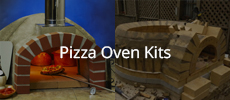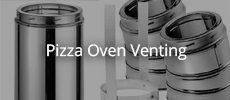Originally posted by Gulf
View Post
Announcement
Collapse
No announcement yet.
36" WF Pompeii Oven in Maryland
Collapse
X
-
I think he was the builder who wanted to be able to move the oven with a forklift?
- Likes 1
-
That is also the intent of the elevating the insulation. It just places the insulation much higher above the water that may collect on the hearth. The idea works for both an igloo and an enclosure. In the US, it is a basic concept built into all homes built on concrete. The dry level that we live on is placed at least 2.5" above the layer that brick are layed. Weep holes are provided on that lower level to allow water to escape to an even lower level to grade.The sloping of the supporting slab is really more important outboard of the perimeter of the outer shell so water runs away from the oven (assuming you are building an igloo style
Leave a comment:
-
I guess that it is all in relation to where you live. In my neck of the woods "dirt daubers" would plug those holes the first season, if the wood storage opening is left open.in my build the mesh is glued to the topside of the supporting slab to prevent wasps and ants entering.
Leave a comment:
-
The sloping of the supporting slab is really more important outboard of the perimeter of the outer shell so water runs away from the oven (assuming you are building an igloo style). In the case of raising the insulation to provide space for moisture movement some gal mesh provides more space but far less height than pavers.
in my build the mesh is glued to the topside of the supporting slab to prevent wasps and ants entering.
Leave a comment:
-
I would not do that. They will get in the way of the screeding. Set them about 1/4 to 1/8th inch below the top of the slab. You can easily rod them out from below later. Elevating the insulation is an alternative to "doming" the slab imo. That is is going to make setting the pavers level difficult if you intend to do both...... I was thinking of making the PVC about 1/2" taller than the slab and then cutting it flush with my angle grinder once the hearth cures.....
Leave a comment:
-
Thanks for the reassurance about the slab, I've definitely got plenty of rebar in there right now (see image below). I was thinking of making the PVC about 1/2" taller than the slab and then cutting it flush with my angle grinder once the hearth cures... I like the bread idea MUCH better! Thanks for the tips!!Originally posted by SableSprings View PostYour rebar lattice within the concrete top slab is providing a lot of structural "strength". Those weep holes will not weaken your slab in either pattern you suggest. And yes, you are putting weep holes only under the insulation board. Remembering to place your 1/2" tubing pieces into the form work also has the advantage of keeping you from hitting a piece of rebar during the "drilling option". Another option to David S suggestion above is to drill holes in your support board and push the tubing pieces just through that board. I would cut the tubing off just below the top projected level of the concrete. I know this may sound stupid, but take some bread wrapped in a bit of plastic wrap and make a taller "cork" for each tube that will stand above the finished concrete.
Another option to David S suggestion above is to drill holes in your support board and push the tubing pieces just through that board. I would cut the tubing off just below the top projected level of the concrete. I know this may sound stupid, but take some bread wrapped in a bit of plastic wrap and make a taller "cork" for each tube that will stand above the finished concrete.
When the concrete is poured, leveled and just starting to stiffen, locate your "bread corks", make a slight depression around each tube that will collect water and drain directly in the tubes. Gulf put pieces of screen over the holes (both ends) to keep bugs from moving up/in and setting up residences. The trick with the bread is that it keeps the concrete out of the tube and is extremely easy to clean out later. I had used wood blocks for my ash slot form void and spent about 2 hours trying to remove the swollen wood after the slab had set.
David's ideas will work great and may be simpler...I just thought you'd like several options to consider. Hope all this makes sense and helps...good luck with your slab pour...don't forget to pound/tap the sides of the forms to release any air bubbles/voids and make the finish smooth(er)
Awesome idea! I still think the pavers wont hurt, but the idea of doming the hearth is excellent! It looks like your screen is on the bottom of your durock, correct? (I assume held in with gorilla glue?)Originally posted by david s View PostYou can use some polystyrene plugs cut to length and insert as you lay the concrete. I also like to dome the slab up in the centre slightly so the centre is about 10 mm higher than the sides. This encourages water flow away from the dome and won’t pool under the floor. You can also raise the insulation off the surface of the supporting slab with something thin like 6 mm gal steel mesh or concrete pavers laid with gaps between them to provide a passageway for water/steam to the weepholes.Last edited by bentedesco; 08-11-2018, 05:49 PM.
Leave a comment:
-
This is mine. I've been doing it this way for 10 years now and it seems to work pretty well. As the heat will drive any moisture away from it the hole releases any steam pressure and provides an exit. I don't think you need too many. I only use one although my ovens are small.
This reminds me of firing a new kiln (empty) very slowly for the first time, when at around 400 C internal water began dripping from a lower corner and forming a pool underneath the kiln approx 200 ml. This occurred because moisture being forced away from the heat condensed against the cooler outer sheeting running down to exit at the lowest corner. I was surprised this took so long to happen and at such a high temperature.
Last edited by david s; 08-11-2018, 03:59 PM.
Leave a comment:
-
Your rebar lattice within the concrete top slab is providing a lot of structural "strength". Those weep holes will not weaken your slab in either pattern you suggest. And yes, you are putting weep holes only under the insulation board. Remembering to place your 1/2" tubing pieces into the form work also has the advantage of keeping you from hitting a piece of rebar during the "drilling option". Another option to David S suggestion above is to drill holes in your support board and push the tubing pieces just through that board. I would cut the tubing off just below the top projected level of the concrete. I know this may sound stupid, but take some bread wrapped in a bit of plastic wrap and make a taller "cork" for each tube that will stand above the finished concrete.
Another option to David S suggestion above is to drill holes in your support board and push the tubing pieces just through that board. I would cut the tubing off just below the top projected level of the concrete. I know this may sound stupid, but take some bread wrapped in a bit of plastic wrap and make a taller "cork" for each tube that will stand above the finished concrete.
When the concrete is poured, leveled and just starting to stiffen, locate your "bread corks", make a slight depression around each tube that will collect water and drain directly in the tubes. Gulf put pieces of screen over the holes (both ends) to keep bugs from moving up/in and setting up residences. The trick with the bread is that it keeps the concrete out of the tube and is extremely easy to clean out later. I had used wood blocks for my ash slot form void and spent about 2 hours trying to remove the swollen wood after the slab had set.
David's ideas will work great and may be simpler...I just thought you'd like several options to consider. Hope all this makes sense and helps...good luck with your slab pour...don't forget to pound/tap the sides of the forms to release any air bubbles/voids and make the finish smooth(er) Last edited by SableSprings; 08-11-2018, 01:42 PM.
Last edited by SableSprings; 08-11-2018, 01:42 PM.
Leave a comment:
-
You can use some polystyrene plugs cut to length and insert as you lay the concrete. I also like to dome the slab up in the centre slightly so the centre is about 10 mm higher than the sides. This encourages water flow away from the dome and won’t pool under the floor. You can also raise the insulation off the surface of the supporting slab with something thin like 6 mm gal steel mesh or concrete pavers laid with gaps between them to provide a passageway for water/steam to the weepholes.Last edited by david s; 08-11-2018, 01:34 PM.
Leave a comment:
-
One last question about weep holes, I'm going to be pouring my slab tomorrow and I just wanted to confirm that the weep holes only need to be underneath where the CaSi board will be, correct?Originally posted by UtahBeehiver View PostYep, that works, a lot of builders forget hence need to drill afterwards
Also, I was thinking about having 5, 1/2" weep holes in an X pattern (one in the center). Would this potentially weaken my hearth?
The other design I had was to do a cross pattern going down the center (from the back of the dome to the front arch). While this might have better functionality, I was worried that 3 holes down the middle of my slab might weaken it?
Leave a comment:
-
Yep, that works, a lot of builders forget hence need to drill afterwards
- Likes 1
Leave a comment:
-
Today was a GREAT day. My father helped me get the base built.
Tomorrow, I need to get 3 more cinder blocks to finish the base and 20 more bricks to complete the form for the hearth and cut the rebar to reinforce the structure.
Hopefully this week I can get the framing for the Durock complete so I can pour my hearth next week!
One question regarding weep holes. Have any of you simply inserted 1/2" PVC tubing into your concrete mold and then poured the concrete around it? I'm thinking this would save me from having to drill into my hearth after the concrete cures.
5 Photos
Leave a comment:
-
Awesome! Thanks for the tips!Originally posted by Gulf View PostI agree. But, I think of the elbow as the minimum height. And, the base of the sturnum (xiphoid process) as the maximum height. In my case that is about a 4" difference. The max works better for me as I don't have to bend over to see the back of the oven. For you, I suggest a cardboard mockup of your oven floor and the opening of the entry. From that, you will be able to fint the correct (ergonomic) height for you .
.
Leave a comment:
-
I agree. But, I think of the elbow as the minimum height. And, the base of the sturnum (xiphoid process) as the maximum height. In my case that is about a 4" difference. The max works better for me as I don't have to bend over to see the back of the oven. For you, I suggest a cardboard mockup of your oven floor and the opening of the entry. From that, you will be able to fint the correct (ergonomic) height for you .
.
- Likes 1
Leave a comment:





Leave a comment: